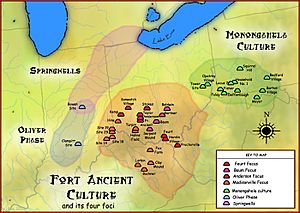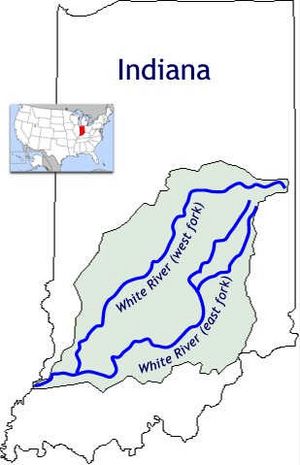Oliver phase facts for kids
The Oliver phase was a group of Native American people who lived in central and southern Indiana a long time ago. They were part of the Late Woodland period, which means they lived between the years 1200 and 1450 CE. These people settled along the east and west branches of the White River.
The Oliver people were skilled farmers who lived in villages. They grew a lot of maize (corn), which was a very important food for them. Their way of life was similar to other groups living nearby during the Late Woodland period, like the Oneota, Fort Ancient, and Monongahela cultures. An archaeologist named James B. Griffin first named this group in 1946. He studied their unique pottery found mostly in Hamilton and Marion counties, especially at a place called the Bowen site.
Life in Oliver Villages
Where They Lived
The Oliver people built their villages, much like their neighbors, the Fort Ancient culture. These villages were often round and protected by tall wooden fences called palisades. Sometimes, they even had ditches around them. Besides large villages, they also lived in smaller farmsteads.
Even though they started in central Indiana, the Oliver people gradually moved southeast over time. Larger villages, like the Clampitt Site in Lawrence County and the Bowen site in Marion County, were about one to two acres in size. They chose to build their homes on flat, fertile land near rivers. This allowed them to grow their crops easily. The Bowen Site, located near Indianapolis, was used by these people at different times.
Oliver Pottery
Archaeologists first learned about the Oliver phase by studying their pottery. Most of their pottery was made up of round jars. These jars were often strengthened with grit (small pieces of rock or sand) mixed into the clay. Their pottery showed a mix of styles from both the Oneota and Fort Ancient cultures, which were other groups living in the Great Lakes area during the Late Woodland period.



